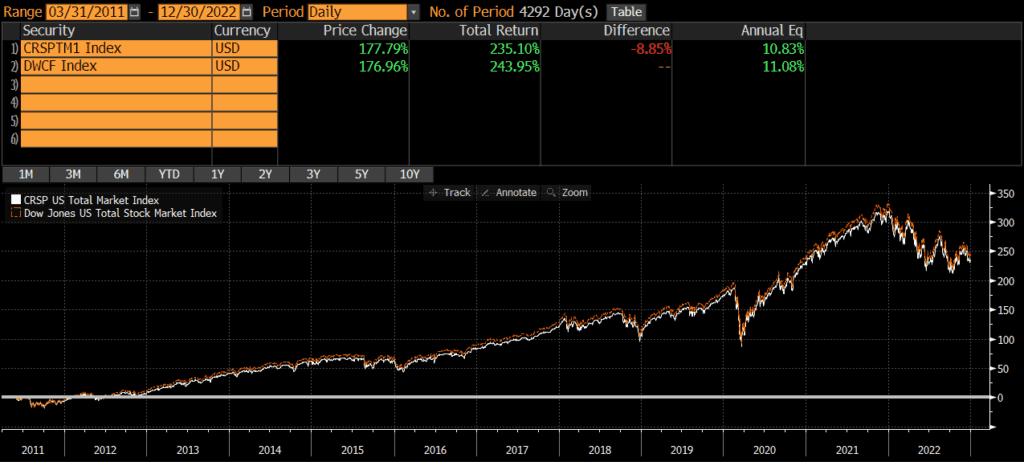The CRSP US Total Market Index and the Dow Jones US Total Stock Market Index are two of the most popular indices of US stocks. Many portfolios and investment vehicles are benchmarked to each index as both are representative of the US stock market.
The CRSP US Total Market Index and the Dow Jones US Total Stock Market Index are nearly identical in every way with very slight differences. The below performance chart of the CRSP US Total Market and the Dow Jones US Total Stock Market indices illustrates that the Dow Jones US Total Stock Market Index has outperformed the CRSP US Total Market Index since its inception. However, returns over the past 11 years have been nearly identical. This is extremely similar to the findings in my analysis of the Russell 1000 vs S&P 500 and MSCI USA Index vs the S&P 500 Index.
A quick note that investors cannot invest directly in an index. These unmanaged indexes do not reflect management fees and transaction costs that are associated with an investable vehicle, such as the Fidelity Total Market Index Fund (symbol: FSKAX) or the Vanguard Total Stock Market Index Fund ETF (symbol: VTI). A reminder that these are simply examples as this site does NOT provide investment recommendations.
Historical Performance: CRSP US Total Market Index vs Dow Jones US Total Stock Market Index
The Dow Jones US Total Stock Market Index was launched way back in 1987, while the CRSP US Total Market Index was launched nearly 25 years later on March 31, 2011. Since that time, the Dow Jones index has outperformed the CRSP index by .25% per year (11.08% vs 10.83%, respectively). The cumulative performance differential over that time period has been less than 9%.

Composition Differences: CRSP vs Dow Jones (US Total Stock Market Indices)
Both the CRSP US Total Market Index and the Dow Jones US Total Stock Market Index are broad-based indices that represent the US equity markets. As of 12/31/2022, the indices have identical geographic exposures, similar sector weights, and slightly different market cap exposures.
Geography
Both the CRSP US Total Market and the Dow Jones US Total Stock Market indices only include the stocks of US-domiciled companies.
Market Capitalization
The two indices have a similar number of constituent stocks (as of 9/30/2022); the CRSP US Total Stock Market Index has 4,027 constituents versus the Dow Jones US Total Stock Market’s 4,273 constituents. Using the Vanguard Total Stock Market Index Fund (which tracks the CRSP benchmark) and the Fidelity Total Stock Market Index Fund (which tracks the Dow Jones index) as proxies, we can infer the below market cap weights of each index. Perhaps not surprisingly, the weights are identical!
| CRSP US Total Stock Market Index | Dow Jones US Total Stock Market Index | |
| Large Cap | 73% | 73% |
| Mid Cap | 19% | 19% |
| Small Cap | 9% | 9% |
Sector Weights
Again, using VTSAX and FSKAX as proxies, we can infer the index weights are approximately identical. Many sector weights are within .05% of each other!
| CRSP US Total Stock Market Index | Dow Jones US Total Stock Market Index | |
| Basic Materials | 2.65% | 2.66% |
| Consumer Cyclical | 10.35% | 10.43% |
| Financial Services | 13.90% | 14.04% |
| Real Estate | 3.48% | 3.46% |
| Communication Services | 6.89% | 6.91% |
| Energy | 5.09% | 5.13% |
| Industrials | 9.80% | 9.58% |
| Technology | 23.04% | 23.18% |
| Consumer Defensive | 6.80% | 6.77% |
| Healthcare | 15.09% | 14.97% |
| Utilities | 2.91% | 2.87% |
Final Thoughts on CRSP vs Dow Jones (US Total Stock Market Indices)
Investors cannot invest in indices directly and should do their own research before deciding to invest in a fund that tracks either index. That being said, these two indices appear nearly identical in terms of geographic, market cap, and sector exposure. For all intents and purposes, I would argue that these two benchmarks are interchangeable, despite the small historical performance difference.
With such a small performance difference though, the costs of investable index strategies may be a larger consideration than which benchmark to select. Sometimes benchmark selection matters quite a bit, although that does not appear to be the case between these two indices.